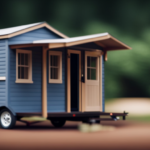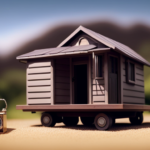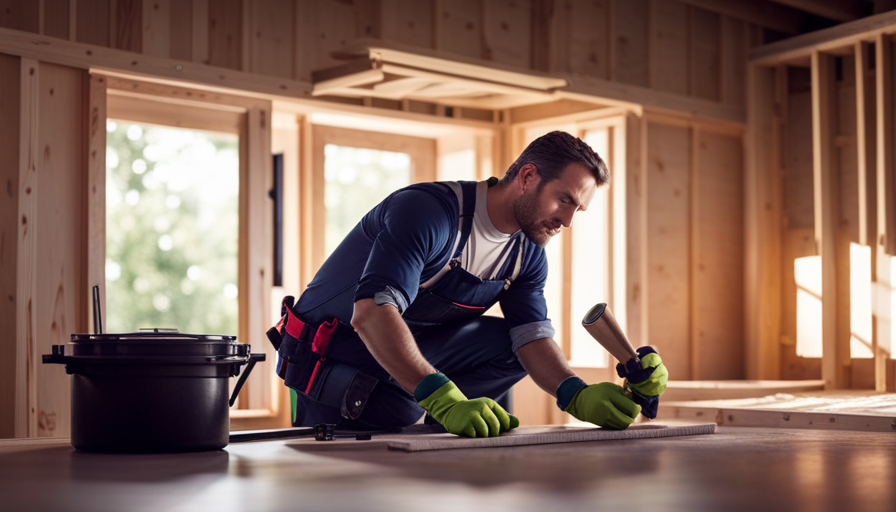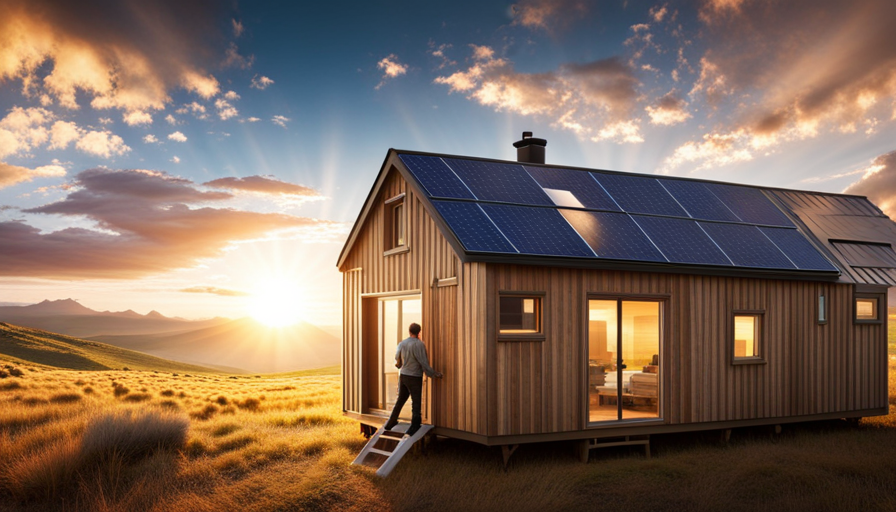Have you ever pondered the weight of a small house? Allow me to provide some insight on this matter.
As the saying goes, ‘big things come in small packages,’ and the same can be said for tiny houses. These compact dwellings have gained popularity for their minimalist lifestyle and eco-friendly nature. But how heavy are they, really?
In this article, we will delve into the nitty-gritty details of tiny house weight. We will explore the factors that contribute to their overall weight, how it affects their mobility and transportation, and tips for keeping them light. We will also debunk common misconceptions surrounding tiny house weight and provide real-life examples to give you a better understanding.
Furthermore, we will guide you on how to calculate the weight of your own tiny house and provide considerations for moving it.
So, if you’re curious about the weight of these pint-sized homes, stick around, because we’re about to embark on a weighty journey!
Key Takeaways
- Tiny houses are gaining popularity for their minimalist lifestyle and eco-friendly nature.
- The weight of a tiny house ranges from 5,000 to 10,000 pounds, with factors such as design, construction, appliances, furniture, and materials contributing to the overall weight.
- Lightweight materials like steel or aluminum are used for the frame and walls of tiny houses to minimize weight.
- Proper weight distribution is crucial for stability, safety, and mobility of a tiny house, and it also affects vehicle fuel efficiency.
Understanding the Basics of Tiny Houses
So, how heavy is a tiny house anyway? When it comes to tiny house construction and design, weight is a critical factor that must be carefully considered.
The average weight of a tiny house can range from 5,000 to 10,000 pounds, depending on its size and materials used. Tiny house design focuses on maximizing space while minimizing weight, which means using lightweight materials such as steel or aluminum for the frame and walls.
Additionally, the size and number of windows, appliances, and furniture can also impact the overall weight of the tiny house. These factors, along with the type of foundation used, insulation, and roofing materials, all contribute to a tiny house’s weight.
Moving forward, let’s explore the various factors that contribute to a tiny house’s weight.
Factors that Contribute to a Tiny House’s Weight
One key element that significantly influences the overall weight of a compact dwelling is the combination of various contributing factors. Realistic weight expectations for a tiny house can vary depending on these factors.
• Design and Construction:
- Type of foundation (trailer, permanent, or skids)
- Wall thickness and insulation
- Roof type and materials
- Flooring materials
- Windows and doors
• Appliances and Furniture:
- Kitchen appliances (refrigerator, stove, etc.)
- Bathroom fixtures (toilet, shower, sink)
- Furniture (bed, seating, storage)
The impact of materials on weight is another crucial consideration. For instance, using lightweight alternatives like aluminum or composite materials for framing, siding, and roofing can reduce the overall weight. However, it’s essential to strike a balance between weight reduction and structural integrity.
As we delve into the subsequent section about the average weight of a tiny house, it becomes clear that understanding these contributing factors is key to estimating the weight accurately.
The Average Weight of a Tiny House
When it comes to compact dwellings, it’s fascinating to discover the average weight they carry. The average weight of a tiny house can vary depending on its size, materials used, and the level of customization. However, on average, a tiny house weighs between 10,000 and 20,000 pounds.
It’s important to note that weight distribution plays a significant role in determining the overall weight of a tiny house. The weight must be evenly distributed throughout the structure to ensure stability and prevent any structural issues. Understanding the average weight and weight distribution of a tiny house is crucial for ensuring its safety and durability.
Moving on to the next section about how weight affects mobility and transportation, it is essential to consider various factors that come into play.
How Weight Affects Mobility and Transportation
To ensure smooth mobility and transportation of your compact dwelling, it’s important to consider how weight impacts its overall maneuverability and safety. Studies have shown that an increase in weight by just 1,000 pounds can reduce a vehicle’s fuel efficiency by up to 1%.
Additionally, weight distribution plays a crucial role in maintaining stability while on the move. Uneven weight distribution can lead to swaying or tipping, compromising the structural integrity of the tiny house. To prevent such issues, it is essential to evenly distribute the weight throughout the tiny house, placing heavier items closer to the center and lighter ones towards the edges.
Furthermore, minimizing the overall weight of the tiny house can enhance its mobility and reduce strain on the towing vehicle. With weight distribution and impact on structural integrity in mind, let’s explore tips for keeping a tiny house light in the subsequent section.
Tips for Keeping a Tiny House Light
Hey, want to know some tricks to keep your compact dwelling light and nimble? Let’s dive into some helpful tips!
When it comes to packing light for your tiny house, there are a few key strategies to keep in mind. First, consider using lightweight building materials for your construction. Materials such as aluminum or composite siding can significantly reduce the overall weight of your tiny house.
Additionally, opt for lightweight furniture and appliances that are specifically designed for small spaces. Another tip is to minimize the number of personal belongings you bring into your tiny house. Be selective and only keep what you truly need.
By following these tips for packing light, you can ensure that your tiny house remains mobile and easy to transport.
Now, let’s explore some common misconceptions about tiny house weight.
Common Misconceptions About Tiny House Weight
Contrary to popular belief, the weight of a compact dwelling can be deceiving. Common misconceptions about tiny house weight can lead to incorrect assumptions about their impact on various aspects. To convey a deeper understanding, consider the following points:
-
Structural Integrity: Many people assume that a lightweight tiny house compromises its structural integrity. However, careful engineering and the use of appropriate materials ensure that these homes are structurally sound and safe.
-
Mobility: Another misconception is that a heavy tiny house cannot be easily moved. In reality, by adhering to weight restrictions and utilizing specialized trailers, tiny houses can be transported with relative ease.
-
Environmental Impact: Some may believe that the weight of a tiny house has a significant negative impact on the environment. However, compared to traditional homes, these compact dwellings typically have a smaller carbon footprint and require fewer resources.
Understanding these common misconceptions and the true impact of weight on tiny houses is crucial. Transitioning into the subsequent section about real-life examples of tiny house weights, it becomes evident that weight does play a role in determining the feasibility and practicality of these dwellings.
Real-Life Examples of Tiny House Weights
One cannot help but be amazed by the astonishingly low weight of these compact dwellings when looking at real-life examples. Despite common misconceptions, tiny houses can be surprisingly lightweight.
For instance, the Tiny Tack House, a popular tiny house design, weighs only 8,840 pounds. Another example is the Minim Home, which weighs a mere 6,800 pounds. These real-life examples defy the belief that tiny houses are heavy and burdensome.
It is important to consider the materials used, such as lightweight steel or aluminum, as well as the design and construction methods employed to achieve such low weights. Understanding the actual weights of existing tiny houses can help dispel the misconceptions surrounding their weight.
Moving on to calculating the weight of your own tiny house, one must take into account various factors such as the materials used, dimensions, and furnishings.
How to Calculate the Weight of Your Own Tiny House
To accurately determine the weight of your own compact dwelling, it’s crucial to consider factors such as the materials used, dimensions, and furnishings. These factors can greatly impact the overall weight, with some tiny houses weighing as little as 3,000 pounds.
Calculating the weight of your tiny house requires a meticulous approach. Here are some key points to consider:
-
Materials: The type and quantity of materials used in the construction play a significant role in determining the weight. For example, using lightweight materials like aluminum instead of heavy wood can reduce the overall weight.
-
Dimensions: The size of your tiny house directly affects its weight. Larger dimensions mean more materials, resulting in increased weight.
-
Furnishings: The weight of your furniture, appliances, and personal belongings must be factored in. Each item adds to the overall weight.
-
Weight distribution: Properly distributing the weight throughout the tiny house is essential for stability and safe transportation. Ensure that heavier items are placed closer to the center to maintain balance.
Considering these factors will help you accurately calculate the weight of your tiny house and plan for its safe movement.
Transitioning into the subsequent section about considerations for moving a tiny house, it’s important to address the challenges that come with relocating such a compact dwelling.
Considerations for Moving a Tiny House
When considering moving a tiny house, there are two main options to consider: hiring professional movers or utilizing DIY moving methods.
Hiring professional movers ensures that the process is handled by experienced professionals who have the necessary equipment and expertise to safely transport the tiny house.
On the other hand, DIY moving methods require careful planning and execution, as well as access to the appropriate equipment and vehicles.
Both options have their advantages and disadvantages, and it’s important to weigh these factors before making a decision.
Hiring Professional Movers
Hiring professional movers can make the process of moving a tiny house much easier and more enjoyable. Here are three reasons why hiring professional help is worth considering:
-
Efficiency: Professional movers have experience in handling and transporting tiny houses, which means they can complete the job quickly and efficiently. They know the best techniques for lifting and securing the house, ensuring a smooth and safe move.
-
Expertise: Moving a tiny house requires knowledge of local regulations and permits. Professional movers are well-versed in these requirements and can handle the necessary paperwork on your behalf. They also have the expertise to navigate narrow roads and tight spaces without causing any damage to the house or surrounding property.
-
Cost-effectiveness: While hiring professional movers may seem expensive initially, it can save you money in the long run. They have the necessary equipment and resources to move the house without any setbacks or delays, minimizing the risk of damage and additional expenses.
By hiring professional movers, you can ensure a hassle-free and efficient move. However, if you prefer a more hands-on approach, you can explore DIY moving methods.
DIY Moving Methods
One option for moving your small dwelling on your own is to enlist the help of friends or family members with experience in logistics, like a friend who has worked as a professional mover. To ensure a smooth and efficient DIY move, it is essential to have the right tools and equipment. Renting the necessary equipment can make the process easier and safer. Here are some DIY moving tools you may need:
| Tool | Description | Rental Cost |
|---|---|---|
| Hand truck | Used for transporting heavy items | $10-$20 |
| Furniture dolly | Helps move large furniture easily | $10-$25 |
| Moving straps | Allow for easier lifting and carrying of objects | $5-$15 |
| Moving blankets | Protect furniture and fragile items during transit | $2-$5 |
Renting these tools will help you save time and effort during your DIY move and ensure the safety of your tiny house.
Frequently Asked Questions
Can I build a tiny house on wheels without considering weight limitations?
No, it’s important to consider weight limitations when building a tiny house on wheels. Building regulations and structural integrity are crucial factors to take into account. Ignoring weight limitations can lead to safety issues and potential damage to the structure.
It’s essential to ensure that the house is designed and constructed to meet the necessary weight restrictions to maintain its stability and durability while on the move.
How much weight can a typical tiny house trailer handle?
A typical tiny house trailer is designed to handle a maximum weight capacity of around 10,000 to 15,000 pounds. To put this into perspective, imagine a fully loaded moving truck carrying furniture, appliances, and personal belongings. Weight distribution is crucial in ensuring the trailer’s stability and preventing any damage or accidents. It’s important to evenly distribute the weight throughout the trailer, placing heavier items towards the center and lighter ones towards the ends.
Are there any legal weight restrictions for towing a tiny house?
When considering towing a tiny house, it’s important to be aware of the weight restrictions imposed by local laws. These restrictions vary by jurisdiction and can include limits on the total weight of the house and trailer combination.
It’s crucial to consult with local authorities and obtain the necessary permits to ensure compliance. However, if you’re building a tiny house on wheels without weight limitations, you have more flexibility in design and materials.
What are the consequences of exceeding the recommended weight limit for a tiny house?
Exceeding the recommended weight limit for a tiny house can have serious consequences. It compromises the structural integrity, making it more susceptible to collapse or damage during transportation. Additionally, it puts a strain on the towing vehicle, affecting its performance and increasing the risk of accidents.
To ensure safety, it’s crucial to adhere to weight restrictions and take necessary safety measures such as distributing the load evenly and securing it properly. Failure to do so can lead to catastrophic outcomes.
Are there any weight-saving measures that can be taken during the construction of a tiny house?
Weight saving techniques can be employed during the construction of a tiny house to ensure a lighter overall structure. The use of lightweight materials such as aluminum or fiberglass can significantly reduce the weight of the house. Additionally, optimizing the design to eliminate unnecessary components or using alternative construction methods like panelized or modular construction can further reduce the weight.
These techniques are crucial in preventing the tiny house from exceeding the recommended weight limit and avoiding potential consequences.
Conclusion
In conclusion, understanding the weight of a tiny house is crucial for its mobility and transportation. Factors such as materials used, appliances, and furnishings all contribute to the overall weight of the house.
Keeping a tiny house light can be achieved through careful planning and choosing lightweight materials. Contrary to common misconceptions, tiny houses aren’t always as light as a feather. Real-life examples show that weights can vary greatly depending on the design and construction.
To calculate the weight of your own tiny house, consider all the components and consult with professionals if needed.
Moving a tiny house requires careful consideration of weight restrictions and transportation methods. Just like a delicate butterfly, the weight of a tiny house can determine its freedom to roam.
Hi, I’m Emma. I’m the Editor in Chief of Tiny House 43, a blog all about tiny houses. While tree houses are often associated with childhood, they can be the perfect adult retreat. They offer a cozy space to relax and unwind, surrounded by nature. And since they’re typically built on stilts or raised platforms, they offer stunning views that traditional homes simply can’t match. If you’re looking for a unique and romantic getaway, a tree house tiny house might just be the perfect option.
















